| Buchhandlung Heesen | Versandbuchhandlung für Evangelische Theologie |
Impressum | |
| Freudenstadt / Loßburg | Datenschutzhinweise | ||
| Tel. 07446 952 418 1 | Buchhandlung.Heesen@t-online.de | ||
| Da unsere Angebote manuell erstellt werden und während des Seitenaufrufes keine Verbindung zu einer Buchdatenbank aufgebaut wird prüfen wir die Verkaufspreise bei Rechnungsstellung auf Richtigkeit und berechnen den gesetzlich festgelegten Buchpreis. Falls sich dadurch eine Preiserhöhung ergibt werden wir Sie vor Versand informieren, Sie können dann diesem Preis zustimmen oder vom Kauf zurücktreten. Hinweise zum Datenschutz und Cookies | |||
| Geschichte und Archäologie Israels | Geschichte Israels (moderne Geschichte...) | Verfolgung / Holocaust | Reiseführer Israel | Judentum / Judaica | Talmud |
| Tall Zira'a.The Gadara Region | ||||
|
Tall Zirā’a is located in the middle of Wādī al-‘Arab, was continuously
occupied for at least 5,000 years, and offers a unique insight into the
way of life of the region’s people. Its outstanding archaeological
significance results from the artesian spring in its centre, which
created optimal settlement conditions over thousands of years. For this
reason, Tall Zirā’a offers an unusual opportunity to compile a
comparative stratigraphy for northern Jordan from the Early Bronze Age
to the Islamic period, while also making it possible to trace cultural
developments in urban life, handicrafts and the history of religion over
long periods. Moreover, here it is possible to study abundant remains
from the Biblical periods in a broad cultural and historical context.
Within the “Gadara Region Project”, archaeologists have explored Tall
Zirā’a for more than 10 years.
The results are presented in nine volumes. Publikation der Ausgrabungen auf dem Tall Zira’a und der Surveys im Umland in den Jahren 2001–2011 Der Siedlungshügel Tall Zira’a im Wadi al-‘Arab in Jordanien war mindestens 5000 Jahre lang besiedelt und gewährt einzigartige Einblicke in die Lebenswelt der Menschen dort. Eine Quelle hat optimale Siedlungsbedingungen geschaffen, weshalb der Ort von besonderem archäologischem Interesse ist: Er ermöglicht eine vergleichende Stratigraphie Nordjordaniens von der Frühbronzezeit bis zur Islamischen Zeit und damit die Nachverfolgung kultureller Entwicklungen im städtischen Leben, im Handwerk und in der Religionsgeschichte. Zudem können die Überreste aus biblischer Zeit in einem weitgefassten kulturellen und historischen Kontext untersucht werden. Im Rahmen des »Gadara Region Project« haben Archäologen zehn Jahre lang am Tall Zira’a gegraben. There are very few places on either side of the Jordan River where it is possible to explore the history of the Southern Levant in such a small area as in the Wadi al-‘Arab. This deeply incised valley with all its diversity is an archaeological stroke of fortune. Numerous springs, fertile soil and a temperate climate afford excellent living conditions. Tall Zira‘a is located in the middle of this valley, and the research focuses on exploring this hill. Continuously occupied for at least 5,000 years, it offers unique insights into the way of life of the region’s people. Its outstanding archaeological significance is a result from the artesian spring located in its centre, which created exceptional settlement conditions over thousands of years. For this reason, Tall Zira‘a offers a unique opportunity to compile an unbroken comparative stratigraphy for northern Jordan from the Early Bronze Age to the Islamic period. It allows to trace cultural developments in urban life, handicrafts and the history of religion over long periods. In addition, it is possible to study the abundant remains from biblical times in the context of other cultural and historical periods. The German Protestant Institute of Archaeology in the Holy Land (GPIA), in cooperation with the Biblical-Archaeological Institute Wuppertal (BAI) as well as with other scholars and scientific institutions, are working on the exploration of the lower section of the Wadi al-?Arab. After the BAI started the archaeological explorations in 2001, the GPIA Institutes in Amman and Jerusalem have participated in the project since 2004 and 2006, respectively. The aim is to explore the diverse civilisations, spanning 8,000 years in the history of humankind, in this geopolitically important wadi, which is attractive not only because of its landscape but also because it served as an important link between the Mediterranean and Transjordan. The most significant site in the Wadi al-?Arab is Tall Zira?a (geographic coordinates: 211 940/225 180). The tall measures approx. 200 m in diameter; its highest point is located at 17 m below sea level. |
||||
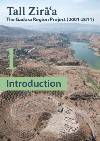 |
Dieter Vieweger / Jutta Häser Tall Zira'a.The Gadara Region Project (2001-2011). Final Report Volume 1: Introduction Gütersloher Verlagshaus, 2017, 296 pages,Hardcover, 978-3-579-08290-5 78,00 EUR  |
Volume 1:
Introduction Aims of the ‘Gadara Region Project’; Tall Zira‘a and the Wadi al-‘Arab; Research History of Tall Zira‘a; the 2001 Tall Zira‘a Survey; Scientific Methods; Framework of Archaeological Work on Tall Zira‘a. Bestattung - Trauerfeiern Leseprobe Download PDF Volume 1 (complete) |
||
| TABLE OF CONTENTS, LISTS
PREFACE, BIBLIOGRAPHY, ACKNOWLEDGEMENTS INTRODUCTION 1. THE GADARA REGION PROJECT / TALL ZIRA‘A 1.1. The ‘Gadara Region Project’ 1.2. Tall Zira‘a 1.3. The Wadi al-‘Arab and its Environment 1.4. Research History for Tall Zira‘a 1.5. Aims of the ‘Gadara Region Project’ 1.6. Bibliography |
2. THE 2001 SURVEY ON TALL ZIRA‘A
2.1. Methodology 2.2. Finds 2.3. The 2001 Survey Results 2.4. Bibliography 3. SCIENTIFIC METHODS 3.1. Animated 3D-Models of Archaeological Excavation Context from Tall Zira´a 3.2. Aerial Survey and Photogrammetry 3.3. Colorimetric Examination of Ceramic 3.4. Experimental Archaeology 3.5. Geophysics 3.6. Landscape Archaeology 3.7. Archaeobotany 3.8. Archaeometry 3.9. Bibliography |
4. FRAMEWORK OF ARCHAEOLOGICAL WORK ON TALL ZIRA‘A 4.1. The Grid System Used at the Excavation 4.2. Stratigraphic Nomenclature and Definition of Areas, Contexts and Finds 4.3. Archaeological Periods in the Southern Levant (A Short Chronology) 4.4. Radiocarbon Samples from Tall Zira‘a 4.5. Bibliography |
||
|
APPENDIX OF PREFACE (Vol. 1: pp. 1–6) |
App. 1.1 Panorama: View over Tall Zirā´a’s plateau.
Panorama taken in 2002 (Source: BAI/GPIA).length 48 s |
App. 1.2 Panorama: View to the
Wādī al-‘Arab (Source: BAI/GPIA). length 19s |
||
|
App. 1.3
|
||||
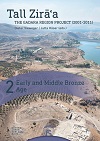 |
Dieter Vieweger / Jutta Häser Tall Zira'a.The Gadara Region Project (2001-2011). Early and Middle Bronze Age Final Report Volume 2: Early and Middle Bronze Age Gütersloher Verlagshaus, 2019, 600 Seiten, gebunden, 978-3-579-08291-2 140,00 EUR  |
Volume 2: Early and Middle Bronze Age Der zweite Band des Grabungsberichts präsentiert Funde aus den Strata 25-17 von Tall Zira'a, die die Besiedlung des Tells zwischen der frühen Bronzezeit II/III und der mittleren Bronzezeit IIB dokumentieren. Ein Erdrutsch hatte in der Zeit von Stratum 16 (vor 1500 v.Chr.) den westlichen Bereich der Siedlung zerstört; ein etwa 120 m2 großes Gebiet im Zentrum von Areal I war davon jedoch nicht betroffen, so dass bedeutende architektonische Zeugnisse aus jener Zeit ausgegraben werden konnten. Funde aus der frühen und mittleren Bronzezeit Download PDF Volume 2 (complete) |
||
|
TABLE OF CONTENTS Lists, Abbreviations Preface, Acknowledgements, Introduction 1. EARLY BRONZE AGE I–III (3600–2300 BC) 1.1. The Early Bronze Age I–III in the Southern Levant 1.1.1. ‘Urban Revolution’ 1.1.2. Early Bronze Age I (3600–3000 BC) 1.1.3. Early Bronze Age II (3000–2700 BC) 1.1.4. Early Bronze Age III (2700–2300 BC) 1.2. The Early Bronze Age II–III on Tall Zira‘a 1.2.1. Early Bronze Age Settlement Strata (Strata 25–22) 1.2.2. Catalogue of Finds – Early Bronze Age II–III (Strata 25–22) 1.2.3. Conclusion 1.3. Bibliography 2. INTERMEDIATE PERIODE: Early Bronze Age IV and Middle Bronze Age I (2300–1950 BC) 2.1. The Intermediate Bronze Age in the Southern Levant 2.2. The Intermediate Bronze Age on Tall Zira‘a 2.2.1. The Intermediate Bronze Age Settlement Strata (Strata 21–20) 2.2.2. Catalogue of Finds – The Intermediate Bronze Age (Strata 21–20) 2.2.3. Conclusion 2.3. Bibliography |
3. MIDDLE BRONZE AGE II (1950–1550 BC) 3.1. The Middle Bronze Age II in the Southern Levant 3.2. The Middle Bronze Age II on Tall Zira‘a 3.2.1. The Middle Bronze Age II Settlement Strata (Strata 19–17) 3.2.2. Catalogue of Finds – The Middle Bronze Age IIA–B (Strata 19–17) 3.2.3. Conclusion 3.3. Bibliography 4. TYPOLOGY OF COOKING POTS from the Early to the Middle Bronze Age by Andrea Schwermer 4.1. Introduction, General remarks 4.2. Early Bronze Age Cooking Pots 4.2.1. Typology 4.2.2. Ornaments 4.2.3. Statistical Evaluation 4.2.4. Comparison with Reference Sites 4.2.5. Conclusion |
4.3.
Middle Bronze Age Cooking Pots 4.3.1. Typology 4.3.2. Decoration and Handles 4.3.3. Statistical Evaluation 4.3.4. Comparison with Reference Sites 4.3.5. Conclusion 4.4. Middle to Late Bronze Age Cooking Pots 4.4.1. Typology 4.4.2. Statistical Evaluation 4.4.3. Comparison with Reference Sites 4.4.4. Conclusion 4.5. Bibliography 5. Faunal Remains from Tall Zira'a by Norbert Benecke 5.1. Introduction 5.2. Animal Keeping 5.2.1. Sheep/Goat. 5.2.2. Cattle 5.2.3. Pig 5.2.4. Equids 5.2.5. Camel 5.2.6. Dog 5.2.7. Cat 5.2.8. Poultry 5.3. Hunting 5.3.1 Wild Mammals 5.3.2 Wild Birds 5.4. Fishing |
||
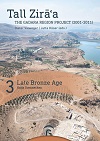 |
Dieter Vieweger / Katja Soennecken Tall Zira'a.The Gadara Region Project (2001-2011). Late Bronze Age Final Report Volume 3: (Strata 16-14) Gütersloher Verlagshaus, 2022, 804 Seiten, gebunden, 978-3-579-08292-9 150,00 EUR  |
Volume 3 . Late Bronze Age
Der Siedlungshügel Tall Zira’a, im Wadi al-‘Arab in Jordanien gelegen, war mindestens 5000 Jahre lang ohne Unterbrechung besiedelt und gewährt einzigartige Einblicke in die Lebenswelt der Menschen jener Region. Eine artesische Quelle in seiner Mitte hat über Jahrtausende optimale Siedlungsbedingungen geschaffen, weshalb der Ort von besonderem archäologischem Interesse ist: Er bietet die seltene Möglichkeit, eine vergleichende Stratigraphie Nordjordaniens von der Frühbronzezeit bis zur Islamischen Zeit zu erstellen und damit kulturelle Entwicklungen im städtischen Leben, im Handwerk und in der Religionsgeschichte über lange Zeiträume hinweg nachzuverfolgen. Zudem können reichlich vorhandene Überreste aus biblischer Zeit in einem weitgefassten kulturellen und historischen Kontext untersucht werden. Im Rahmen des »Gadara Region Project« haben Archäologen zehn Jahre lang am Tall Zira’a gegraben. Die Ergebnisse der Grabungssessionen werden in geplanten neun Bänden in englischer Sprache präsentiert. Einzigartige Einblicke in die Lebenswelt einer lang vergangenen Zeit Lebenswelten vergangener Zeiten Ein archäologisches Kleinod Download PDF Volume 3 (complete) |
||
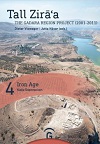 |
Katja Soennecken Iron Age (Strata 13-9) Gütersloher Verlagshaus, 2024,1188 Seiten, gebunden, 978-3-579-08293-6 278,00 EUR  |
Volume 4: Iron Age In diesem Band werden die eisenzeitlichen und persischen Schichten 13 bis 9 des Tall Zira'a vorgestellt. Sie repräsentieren die Besiedlung des Tall vom Ende der Spätbronzezeit/Eisenzeit bis zur persischen Periode. Enthalten sind auch Keramikplatten aus den Strata 16 bis 9. Download PDF Volume 4 (complete) |
||
| TABLE OF CONTENTS Lists, Abbreviations Preface, Acknowledgements, Introduction by Katja Soennecken Bibliography 1. THE TRANSITION FROM BRONZE AGE TO IRON AGE by D. Vieweger/K. Soennecken 1.1. The Historical Situation 1.2 The Background of the Collapse 1.3. Tall Zira‘a in Comparison to its Neighbours 1.3.1. The North 1.3.2. Cisjordan 1.3.3. Transjordan 1.3.3.1. Architecture 1.3.3.2. Pottery and Small Finds 1.3.4. Egypt—Syria/Mesopotamia 1.3.5. Trade Routes 1.3.6. Society 1.4. Summary 1.5. Bibliography 2. IRON AGE I by D. Vieweger/K. Soennecken 2.1 Iron Age I in the Southern Levant 2.1.1. Urban Structures / Architecture 2.1.2. Pottery 2.1.3. International Trade / Crafts 2.1.4. Temple and Mortuary Cult 2.2. The Iron Age I on Tall Zira’a 2.2.1. Stratum 13: The Transition from the Late Bronze Age to the Iron Age I 2.2.1.1. Complex A 2.2.1.2. Complex B 2.2.1.3. Complex C 2.2.1.4. Complex D 2.2.1.5. Complex E 2.2.1.6. Complex F 2.2.1.7. Complex G 2.2.1.8. Complex H 2.2.1.9. Complex I 2.3. Catalogue of Finds—Iron Age I (Stratum 13) 2.3.1. Catalogue of Metal Finds 2.3.2. Catalogue of Faience, Glass and Glazed Pottery Finds 2.3.2.1. Faience Finds 2.3.2.2. Glass Finds 2.3.2.3. Glazed Pottery Finds 2.3.2.4. Raw Glass Finds 2.3.3. Catalogue of Stone Finds by Hans-Martin Jakubik/Benjamin Schröder/Katja Soennecken 2.3.3.1. Terms and Types 2.3.3.2. Catalogue of Stone Finds: Stratum 13 2.3.4. Catalogue of Worked Bone Finds 2.3.5. Catalogue of Pottery Finds by Andrea Schwermer 2.3.5.1. Introduction 2.3.5.2. Vessel Types 2.4. Conclusion/Summary 2.4.1. Architecture 2.4.2. Dating 2.4.3. Pottery 2.5. Bibliography |
3. IRON AGE II by D. Vieweger /K. Soennecken 3.1. Iron Age II in the Southern Levant 3.1.1. The Controversy on the Beginning of Iron Age IIA 3.1.2. Iron Age IIA 3.1.3. Iron Age IIB and IIC 3.1.4. Development of Different Features 3.1.4.1. Urban Development and Architecture 3.1.4.2. Pottery 3.1.4.3. International Trade and Craftmanship 3.1.4.4. Temple and Cult 3.1.4.5. Mortuary Practice 3.2. The Iron Age II on Tall Zira‘a 3.2.1. Stratum 12 3.2.1.1. Complex A 3.2.1.2. Complex B 3.2.1.3. Complex C 3.2.1.4. Complex D 3.2.1.5. Complex E 3.2.1.6. Complex F 3.2.1.7. Complex G 3.2.2. Stratum 11 3.2.2.1. Complex A 3.2.2.2. Complex B 3.2.2.3. Complex C 3.2.2.4. Complex D 3.2.2.5. Complex E 3.2.2.6. Complex F 3.2.2.7. Complex G 3.2.3. Catalogue of Finds – Iron Age IIA/B (Strata 12–11) 3.2.3.1. Catalogue of Metal finds (Strata 12–11) 3.2.3.2. Catalogue of Faience, Glass and Glazed Pottery Finds (Strata 12–11) 3.2.3.3. Catalogue of Stone Finds (Strata 12–11) by H.-M. Jakubik/K. Soennecken 3.2.3.4. Catalogue of Worked Bone Finds (Strata 12–11) 3.2.3.5. Catalogue of Ceramic Finds (Strata 12–11) by A. Schwermer 3.2.4. Stratum 10. 3.2.4.1. Complex A 3.2.4.2. Complex B 3.2.4.3. Complex C 3.2.4.4. Complex D 3.2.4.5. Comples E 3.2.4.6. Complex F (Area II) 3.2.5. Catalogue of Finds – Iron Age IIC (Stratum 10) 3.2.5.1. Catalogue of Metal Finds (Stratum 10) 3.2.5.2. Catalogue of Faience, Glass and Glazed Pottery Finds (Stratum 10) 3.2.5.3. Catalogue of Stone Finds (Stratum 10) by H.-M. Jakubik/K. Soennecken 3.2.5.4. Catalogue of Worked Bone Finds (Stratum 10) 3.2.5.5. Catalogue of Ceramic Finds (Stratum 10) by A. Schwermer 3.3. Conclusion / Summary 3.3.1. Summary Stratum 12 3.3.2. Summary Stratum 11 3.3.3. Summary Stratum 10 3.3.4. Chronology 3.4. Bibliography |
4. THE PERSIAN PERIOD 4.1. The Persian Period in the Southern Levant by D. Vieweger/K. Soennecken 4.1.1. Historical Overview 4.1.1.1. The Ascend of Persian Might 4.1.1.2. Restructuring the World of the Near East – Darius I (522–486 BC) 4.1.1.3. The Fate of the Persian Empire in the Fourth Century BC 4.1.1.4. The Macedonian Attack on the Persian Empire 4.1.1.5. The conquest of the Levant and Egypt (332 BC) by Alexander the Great 4.1.1.6. The End of the Achaemenid Empire 4.1.2. The Southern Levant during the Persian Period (539–331 BC) – Iron Age III (c. 520–300 BC) 4.1.2.1. Administration, Trade and Culture in the Southern Levant 4.1.2.2. The Regions of the Southern Levant 4.2. The Persian Period on Tall Zira‘a by K. Soennecken 4.2.1. Stratum 9 – Persian Period (Sixth to End of Fourth Century BC) 4.2.1.1. Area I 4.2.1.2. Area II 4.3. Conclusion/ Summary 4.4. Bibliography 5. TYPOLOGY OF COOKING POTS FROM THE IRON AGE by A. Schwermer 5.1. Introduction 5.2. General Remarks 5.3. Typology 5.4. Decoration 5.5. Handles 5.6. Statistical Evaluation 5.6.1. Dimensions 5.6.2. Allocation to the Different Types 5.6.3. Distribution among the Strata 5.7. Comparison with Reference Sites 5.7.1. Transjordan 5.7.2. Cisjordan 5.8. Conclusion 5.9. Bibliography 6. CERAMIC PLATES 6.1. Ceramic Finds of Stratum 16 6.2. Ceramic Finds of Stratum 15 6.3. Ceramic Finds of Stratum 14 6.4. Ceramic Finds of Stratum 13 6.5. Ceramic Finds of Stratum 12 6.6. Ceramic Finds of Stratum 11 6.7. Ceramic Finds of Stratum 10 |
||
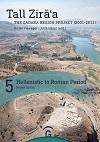 |
Susan Schütz Hellenistic to Roman Period Strata 8-6 Gütersloher Verlagshaus, 2024, 392 Seiten, gebunden, 978-3-579-08294-3 129,00 EUR  |
Volume 5: Hellenistic to Roman Period Dieser Band enthält die Beschreibung und Auswertung der architektonischen Überreste und Funde von der hellenistischen bis zur römischen Zeit auf dem Tall Zira'a. Wie die Funde belegen, datiert die Besiedlung in die erste Hälfte des dritten Jahrhunderts vor Christus. Die architektonischen Überreste weisen auf eine befestigte Siedlung aus dem zweiten Jahrhundert v. Chr. hin. Zwischen dem Ende des ersten Jahrhunderts v. Chr. und der ersten Hälfte des ersten Jahrhunderts n. Chr. wurde ein ausgedehntes, unbewehrtes Gehöft errichtet. Die vorliegenden Forschungen bilden nicht nur einen wichtigen Baustein für die Siedlungsgeschichte von Tall Zira'a, sondern tragen auch zum Verständnis der Siedlungsgeschichte im nördlichen Jordanien und der südlichen Levante im Allgemeinen und der ländlichen Gebiete im Besonderen bei. Inhaltsverzeichnis Leseprobe Download PDF Volume 5 (complete) |
||
|
TABLE OF CONTENTS Lists, Abbreviations Preface, Acknowledgements, Introduction by Susan Schütz/Jutta Häser Bibliography 1. RELEVANT HISTORICAL INFORMATION AND PERIODISATION 1.1. The Hellenistic Period 1.2. The Roman Period 1.3. Periodisation 1.4. Definition of the Decapolis 2. STRATUM 8: HELLENISTIC PERIOD 2.1. General Information 2.2. Complexes Stratum 8 2.2.1. Complex A: Outer Settlement 2.2.2. Complex B: Enclosing Wall 2.2.3. Complex C: Residential Development 2.2.3.1. Comparable Settlement Types 2.2.3.2. Phoenician Influence at the Tall Zira‘a? 2.2.4. Complex D: Entrance Area to the Settlement 2.2.5. Features in Area I 2.3. Find Analysis 2.3.1. Pottery 2.3.1.1. Distribution of Pottery Finds 2.3.1.2. Repertoire of Shapes 2.3.1.3. Terracotta Head TZ 007430-001 2.3.1.4. Summary 2.3.2. Metal Finds 2.3.2.1. Distribution of Metal Finds 2.3.2.2. Repertoire of Shapes 2.3.2.3. Regarding the Potential for Interpreting Nails and their Usage 2.3.2.4. Summary 2.3.3. Coins 2.3.3.1. Ptolemaic Coins 2.3.3.2. Seleucid Coins 2.3.3.3. Hasmonean Coins 2.3.3.4. Unspecified Hellenistic Coins 2.3.3.5. Summary 2.3.4. Glass Finds 2.3.4.1. Distribution of Glass Finds 2.3.4.2. Repertoire of Shapes 2.3.4.3. Summary 2.3.5. Animal Bones 2.3.5.1. Distribution of Bone Finds 2.3.5.2. Identifying the Bone Finds 2.3.5.3. Summary 2.3.6. Stone Finds 2.3.6.1. Distribution of Stone Finds 2.3.6.2. Repertoire of Shapes 2.3.6.3. Summary 2.4. Overall Evaluation of the Hellenistic Stratum |
3. STRATUM 7c, 7b, 7a: EARLY ROMAN PERIOD 3.1. General Information 3.2. Complexes Stratum 7 c: First Construction Phase 3.2.1. Complex A: House with Olive/Wine Press 3.2.2. Complex B: House Structure 3.2.3. Complex C: House Structure 3.2.4. Complex D: Residential and Farm Building 3.2.4.1. Stratum 7 b: First Reconstruction Phase 3.2.4.2. Stratum 7 a: Second Reconstruction Phase 3.2.4.3. Comparable Domestic Developments 3.2.4.4. Additional Features from Stratum 7 Area I 3.2.5. Complex E: Farmstead 3.2.5.1. Considerations on Reconstruction 3.2.5.2. Room Descriptions 3.2.5.3. Farmsteads in the Region of Israel and Jordan 3.2.5.4. Farmyards and Projections – Architectural Features 3.2.5.5. Summary 3.2.6. Complex F: Building Structure 4. STRATUM 6c, 6b, 6a: (EARLY) ROMAN PERIOD 4.1. General Information 4.2. Complexes Stratum 6 c: First Construction Phase 4.2.1. Complex D: Living Quarters 4.2.1.1. Stratum 6 b: First Reconstruction Phase 4.2.1.2. Stratum 6 a: Second Reconstruction Phase 4.2.1.3. Additional Contexts from Stratum 6 Area I 4.2.1.4. Summary 4.2.2. Complex E: Farmstead 4.2.2.1. Room Backfill E 1 – E 12 4.2.2.2. Reconstruction and Room Filling E 13 – E 26 4.2.2.3. Summary 4.2.3. Complex F: Residential Structure 4.2.3.1. Further Contexts from Stratum 6 Area II 4.2.4. Geomagnetic Surveys 4.3. Evaluation of Finds from Stratum 7 and 6 4.3.1. Pottery 4.3.1.1. Distribution of Pottery Finds 4.3.1.2. Repertoire of Shapes 4.3.1.3. Pottery Wheels (Bearings) and Handmade Pottery 4.3.1.4. Summary 4.3.2. Metal Finds 4.3.2.1. Distribution of Metal Finds 4.3.2.2. Repertoire of Shapes 4.3.2.3. Summary 4.3.3. Coins 4.3.3.1. Herodian Coins 4.3.3.2. Early Roman Imperial Coins 4.3.3.3. Summary 4.3.4. Glass Finds 4.3.4.1. Distribution of Glass Finds 4.3.4.2. Repertoire of Shapes 4.3.4.3. Summary 231 |
4.3.5. Animal Bones 4.3.5.1. Distribution of Bone Finds 4.3.5.2. Assessment of the Bone Material 4.3.5.3. Worked Bones 4.3.5.4. A Falcon-headed Shell in the Style of the Tridacna Clams 4.3.5.5. Summary 4.3.6. Stone Finds 4.3.6.1. Distribution of Stone Finds 4.3.6.2. Repertoire of Shapes 4.3.6.3. Summary 246 4.3.7. Wall Paintings 4.4. Dating 4.4.1. Features Relevant for Dating: Stratum 7 4.4.2. Features Relevant for Dating: Stratum 6 4.4.3. Summarising Consideration of the Dating Taking into Account the Evaluation of Finds 4.5. Overall Evaluation of Roman Strata 5. CONCLUSION 6. PLATES AND CATALOGUE OF FINDS FROM TALL ZIRA‘A 6.1. Catalogue of Selected Hellenistic Ceramic Finds 6.2. Catalogue of Hellenistic Coins 6.3. Catalogue of Selected Hellenistic Glass Finds 6.4. Catalogue of Selected Metal Finds (Repertoire of forms, Stratum 8) (without plates) 6.5. Catalogue of Selected Bone Finds (Stratum 8) (without plates) 6.6. Catalogue of Selected Stone Finds (Stratum 8) (without plates) 6.7. Catalogue of Selected Early Roman Ceramic Finds 6.8. Catalogue of Selected Early Roman Ceramic Finds (without plates) 6.9. Catalogue of Early Roman Coins 6.10. Catalogue of Middle and Late Roman Coins 6.11. Catalogue of Indefinite Coins 6.12. Catalogue of Roman Glass 6.13. Catalogue of Selected Metal Finds (Repertoire of forms, Strata 7 and 6) (without plates) 6.14. Catalogue of Selected Bone and Mollusc Finds (Stratum 7 and 6) (without plates) 6.15. Catalogue of Selected Stone Finds (Strata 7 and 6) (without plates)) 6.16. Catalogue of Selected Wall Paintings (Strata 7 and 6) (without plates) 7. BIBLIOGRAPHY |
||
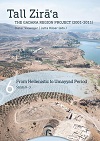 |
Frauke Kenkel, Stefanie Hoss Tall Zira'a.The Gadara Region Project (2001-2011). Hellenistic to Umayyad Period Final Report Volume 6 Hellenistic to Umayyad Period Gütersloher Verlagshaus, 2020, 451 Seiten, gebunden, 978-3-579-08295-0 140,00 EUR  Leseprobe |
Volume
6 Hellenistic to Umayyad Period (Strata 8–3). Ceramic, Glass and Metal Finds Der Siedlungshügel Tall Zira’a, im Wadi al-‘Arab in Jordanien gelegen, war mindestens 5000 Jahre lang ohne Unterbrechung besiedelt und gewährt einzigartige Einblicke in die Lebenswelt der Menschen jener Region. Eine artesische Quelle in seiner Mitte hat über Jahrtausende optimale Siedlungsbedingungen geschaffen, weshalb der Ort von besonderem archäologischem Interesse ist: Er bietet die seltene Möglichkeit, eine vergleichende Stratigraphie Nordjordaniens von der Frühbronzezeit bis zur Islamischen Zeit zu erstellen und damit kulturelle Entwicklungen im städtischen Leben, im Handwerk und in der Religionsgeschichte über lange Zeiträume hinweg nachzuverfolgen. Zudem können reichlich vorhandene Überreste aus biblischer Zeit in einem weitgefassten kulturellen und historischen Kontext untersucht werden. Im Rahmen des »Gadara Region Project« haben Archäologen zehn Jahre lang am Tall Zira’a gegraben. Die Ergebnisse der Grabungssessionen werden in geplanten neun Bänden in englischer Sprache präsentiert. Volume 6, Hellenistic to Umayyad Period (Strata 8–3) Ceramic, Glass and Metal Finds Frauke Kenkel and Stefanie Hoss Editors: Dieter Vieweger and Jutta Häser Download PDF Volume 6 (complete) |
||
| TABLE OF CONTENTS Lists, Abbreviations Preface, Acknowledgements, Introduction 1. THE HELLENISTIC, ROMAN AND BYZANTINE POTTERY by Frauke Kenkel 1.1. Introduction 1.2. Imports 1.2.1. Hellenistic Imports 1.2.2. Roman Imports 1.2.3. Byzantine Imports 1.3. Table Wares. 1.3.1. Plates 1.3.2. Small Bowls 1.3.3. Pouring and Drinking Vessels 1.4. Cooking Vessels 1.4.1. Baking Plates 1.4.2. Pans 1.4.3. Casseroles 1.4.4. So-called ‘Galilean Bowls’ 1.4.5. Cooking Pots 1.4.6. Cooking Jars 1.4.7. Lids 1.5. Everyday Vessels 1.5.1. Bowls 1.5.2. Kraters 1.5.3. Mortaria 1.5.4. Basins 1.5.5. Jars/Jugs 1.5.6. Strainers 1.5.7. Stands 1.5.8. Amphorae 1.5.9. Pithoi 1.5.10. Lids 1.6. Vessels for Personal Use 1.6.1. Amphoriskoi 1.6.2. Unguentaria 1.6.3. Onehandled Juglets for Perfume and Oil 1.6.4. Small Ointment Pots |
1.7. Oil
Lamps 1.7.1. Hellenistic Wheel-Made Oil Lamps 1.7.2. Hellenistic Mould-made Oil Lamps 1.7.3. Roman Wheel-Made Oil Lamps 1.7.4. Roman Mould-Made Oil Lamps 1.7.5. Byzantine Oil Lamps 1.8. Hellenistic and Roman Terracottas 1.8.1. Seated Female Draped Figurines (‘Mourning Isis’?) 1.8.2. Standing Human Figurines 1.8.3. Animals 1.8.4. Altars 1.8.5. Unkown Fragments 1.9. Conclusions 1.10. Bibliography 2. THE HELLENISTIC TO UMMAYYAD GLASS FINDS by Stefanie Hoss 2.1. Introduction 2.1.1. Scope of the Study 2.1.2. Glass Research in the Near East 2.1.3. Research Questions 2.1.4. Methodology 2.2. Typology 2.2.1. Mould-made Slumped Glass 2.2.2. Free-blown Glass 2.2.3. Other 2.3. Analysis 2.3.1. Hellenistic Period (332–63 BC) 2.3.2. Early Roman Period (63 BC–50 AD) 2.3.3. Mid-Roman Period (50–150 AD) 2.3.4. Late Roman Period (150–324 AD) 2.3.5. Byzantine Period (324–636 AD) 2.3.6. Early Islamic/Umayyad Period (636–749 AD) 2.4. Summary and General Conclusions 2.5. Catalogue 2.5.1. Mould-made Slumped Glass 2.5.2. Free-blown Glass 2.5.3. Other 2.6. Concordance Lists 2.7. Bibliography |
3. THE HELLENISTIC TO ISLAMIC METAL FINDS by Stefanie Hoss 3.1. Introduction 3.2. Analysis 3.2.1. Group 1. Personal Accessories 3.2.2. Group 2. House and Furniture 3.2.3. Group 3. Military 3.2.4. Group 4. Trade and Industry 3.2.5. Group 5. Miscellaneous 3.3. Summary and Conclusions 3.4. Catalogue 3.5. Concordance List 3.6. Bibliography |
||
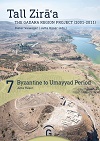 |
Dieter Vieweger Tall Zira'a. Byzantine to Umayyad Period (Strata 5-3) Final Report Volume 7 Gütersloher Verlagshaus, 2024, 552 Seiten, gebunden, 978-3-579-08296-7 168,00 EUR  |
Volume 7 Byzantine to Umayyad
Period (Strata 5-3) Dieser Band enthält die Beschreibung und Auswertung der architektonischen Überreste und Funde von der spätrömischen bis zur umayyadischen Zeit. Die Gebäude, Münzen und Alltagsgegenstände zeugen von der Gründung einer ländlichen Siedlung in spätrömischer Zeit, neben der in byzantinischer Zeit ein Kloster errichtet wurde. Eine griechische Inschrift, die Mönche und einen hohen Kirchenbeamten nennt, zeugt von der Bedeutung des Klosters. Auch nach der islamischen Eroberung im Jahr 636 n. Chr. blieben sowohl die Siedlung als auch das Kloster bestehen. Im Jahr 749 n. Chr. fanden die Siedlung und der Klosterbau durch ein verheerendes Erdbeben ein dramatisches Ende. Danach gab es bis zur Mamlukenzeit keine nennenswerte Wiederbesiedlung mehr. Leseprobe Download PDF Volume 7 (complete) |
||
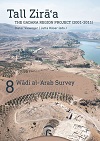 |
Dieter Vieweger Tall Zira'a.The Gadara Region Project (2001-2011). Wadi al-`Arab Survey Final Report Volume 8 Wadi al-`Arab Survey Gütersloher Verlagshaus, 2021, 2 Bände 172 und 844 Seiten, gebunden, 978-3-579-08297-4 278,00 EUR  |
Volume 8 Wadi al-`Arab Survey Der Siedlungshügel Tall Zira’a, im Wadi al-‘Arab in Jordanien gelegen, war mindestens 5000 Jahre lang ohne Unterbrechung besiedelt und gewährt einzigartige Einblicke in die Lebenswelt der Menschen jener Region. Eine artesische Quelle in seiner Mitte hat über Jahrtausende optimale Siedlungsbedingungen geschaffen, weshalb der Ort von besonderem archäologischem Interesse ist: Er bietet die seltene Möglichkeit, eine vergleichende Stratigraphie Nordjordaniens von der Frühbronzezeit bis zur Islamischen Zeit zu erstellen und damit kulturelle Entwicklungen im städtischen Leben, im Handwerk und in der Religionsgeschichte über lange Zeiträume hinweg nachzuverfolgen. Zudem können reichlich vorhandene Überreste aus biblischer Zeit in einem weitgefassten kulturellen und historischen Kontext untersucht werden. Im Rahmen des »Gadara Region Project« haben Archäologen zehn Jahre lang am Tall Zira’a gegraben. Die Ergebnisse der Grabungssessionen werden in geplanten neun Bänden in englischer Sprache präsentiert. Leseprobe Download PDF Volume 8,1 (complete) Download PDF Volume 8,2 (complete) |
||
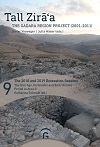 |
Katharina Schmidt The 2018 and 2019 Excavation Seasons: The Iron Age, Hellenistic and Early Roman Period in Area II Final Report Volume 9 Gütersloher Verlagshaus, 2022, 512 Seiten, gebunden, 978-3-579-08298-1 140,00 EUR  |
Volume 9: The Iron Age,
Hellenistic and Early Roman Period Der Band 9 präsentiert die Ergebnisse der Grabungsaktivitäten 2018 und 2019 des im Frühjahr 2018 wieder aufgenommenen Gadara Region Project. Die seit 2018 in Zira'a durchgeführten Grabungs- und Forschungssaisons sind der Siedlungsgeschichte der Eisenzeit II bis zur hellenistischen Zeit in Areal II gewidmet. Mit der Fortsetzung der Ausgrabungen sollte ein weiterer Einblick in die detaillierte chronologische Abfolge der Besiedlung von Zira'a zwischen der Eisenzeit II und der hellenistischen Periode gewonnen und insbesondere im nördlichen Bereich des Tall, in Areal II, das die größte Ansammlung von Bauschutt aufweist, weiterverfolgt werden. Der vorliegende Band "Die Ausgrabungssaison 2018 und 2019" stellt eine einzelne Monographie der Tall Zira'a Publication Series dar. Einzigartige Einblicke in die Lebenswelt einer lang vergangenen Zeit Download PDF Volume 9 (complete) |
||
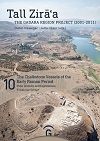 |
Friederike
Schöpf The Chalkstone Vessels of the Early Roman Period. Final Report Volume 10. Their Contexts and Implications Gütersloher Verlagshaus, 2025, 300 Seiten, gebunden, 978-3-579-08300-1 129,00 EUR  |
Volume 10: The Chalkstone Vessels of the
Early Roman Period. Einzigartige archäologische Einblicke Auf dem Tall Zira'a im Nordwesten Jordaniens wurden zwischen 2003 und 2011 sowie 2014 Ausgrabungen durch das Deutsche Evangelische Institut für Archäologie des Heiligen Landes und das Biblisch-Archäologische Institut Wuppertal durchgeführt. Es wurden drei Bereiche geöffnet und archäologische Überreste aus einer Zeit von mehr als 5000 Jahren freigelegt. Bis heute ist der Tall Zira'a ein prominenter Ort im Wadi al-'Arab. Er ist gut sichtbar, durch steile Hänge natürlich geschützt, bietet auf seinem Plateau genügend Platz für eine große Siedlung und ist von reichlich Acker- und Weideland umgeben. Darüber hinaus verfügte der Tall über eine artesische Quelle und lag an einer nahe gelegenen antiken Handelsstraße. Dieser Band konzentriert sich auf die klassischen Perioden in Tall Zira'a, insbesondere die späthellenistische und frühen römischen Epoche (Strata 8-6). Bemerkenswerterweise haben die Ausgrabungen in Tall Zira'a eine beträchtliche Anzahl von Kalksteingefäßen aus diesen Epochen freigelegt. Diese Gefäße werden als jüdische religiöse Objekte interpretiert, die mit den Vorschriften der rituellen Reinheit. Sie sind vergleichbar mit zeitgenössischen Funden in Jerusalem, im weiteren Judäa, in Peräa und Galiläa. Zusammen mit anderen Kleinfunden weisen sie auf enge Verbindungen zwischen den Bewohnern von Tall Zira'a und diesen Regionen. Der Band gibt einen Überblick über die in Tall Zira'a gefundenen Kalksteingefäße und ihre Bedeutung für die jüdischen Reinheitsvorschriften. Die Ergebnisse werden verglichen mit denen aus anderen zeitgenössischen Siedlungen in der südlichen Levante verglichen und in den Kontext Textquellen aus diesen Perioden kontextualisiert. Die materielle Kultur von Tall Zira'a spiegelt die Spannungen, Veränderungen und politischen Einflüsse in der Region während der hellenistischen und römischen Periode wider und bietet wertvolle Einblicke in die Beziehungen zwischen verschiedenen kulturellen Einheiten und die politische Entwicklung der südlichen Levante. Download PDF Volume 10 (complete) |
||
| TABLE OF CONTENTS 1. HISTORY AND METHODOLOGY 1.1. Terminology 1.1.1. Nation(s) and Nationalism / Ethnicity 1.1.2. Material Culture 1.1.3. Geographical Terms 1.1.4. Diaspora 1.1.5. Jew/Judaean/Israelite 1.2. Historical Background 1.3. Purity as an Identity Marker 2. JEWISH PURITY PRACTICES DURING THE LATE SECOND TEMPLE PERIOD 2.1. Defining Purity and Impurity 2.2. Practising Purity 2.3. The Hierarchy of Purity 2.4. Gentile Influences on Jewish Purity Practice 2.5. Individual Purity of the Rabbis and its Decline in Jewish Society 3. THE EMERGENCE OF PURITY LITERATURE 3.1. The First Phase of a New Purity Approach: Texts in the Tanakh 3.1.1. Ezekiel 3.1.2. Ezra and Nehemia 3.1.3. Conclusion 3.2. Entering the Private Sphere: Purity, Family and Individuals in the Apocrypha 3.2.1. Tobit 3.2.2. Judith 3.2.3. 1 Maccabees 3.2.4. Conclusion 3.3. Taking Purity to a New Level: The Dead Sea Scrolls 3.3.1. Separation from the Others and Unrighteous Jews 3.3.2. The Purity of the Temple 3.3.3. Corpse Impurity and the Impurity of Stone 3.3.4. Full-Body Immersion 3.3.5. Female Polluting Powers 3.3.6. Summary 3.4. Historical Sources: Josephus 3.5. Purity of the Soul: Diasporic Literature 3.5.1. The Letter of Aristeas 3.5.2. Philo of Alexandria (15/10 BC–45/50 AD) 3.6. Conclusion |
4. ‘PURE’ MATERIAL CULTURE 4.1. Chalkstone Vessels 4.1.2. Vessel Types 4.1.3. Production Methods and Sites 4.1.4. The Significance of Chalkstone Vessels 4.2. Stone Ossuaries 4.2.1. The New Burial Custom 4.3. Pottery 4.4. Ritual Stepped Pools 4.5. Conclusion 5. THE EVIDENCE FROM TALL ZIRA?A 5.1. Tall Zira?a in its Regional Context 5.2. Archaeological Research from 2003–2011 and 2018–2019 5.2.1. Area I 5.2.2. Area II 5.2.3. Area III 5.2.4. The Classical Periods at Tall Zira?a 5.3. The Chalkstone Vessels 5.3.1. The Typology 5.3.1.1. Hand-carved Vessels 5.3.1.2. Lathe-turned Vessels 5.3.1.3. Fragments (Plates 5.45–5.47) 5.4. Contextualization of the Finds ? 5.4.1. Distribution in the Areas 5.4.2. The Find Contexts of Areas I, II, and III 5.4.3.1. Dating 5.4.3.2. Origin of Types 5.5. The Historical Context, or where did the Jews come from? 5.5.1. Rural Jewish Settlements in the Chora of the Decapolis 5.5.2. The Households in Tall Zira?a 5.5.3. Where is the Ritual Stepped Pool? 5.6. Summary 5.7. Catalogue and Plates 5.7.1. Hand-carved Vessels with Chisel Marks: Type I. A. 5.7.1.1. Mugs and Pitchers: Type I. A. Form 1. OV 5.7.1.2. Bowls: Type I. A. Form 2. OV 5.7.2. Polished Open Hand-carved Vessels: Type I. B. 5.7.2.1. Mugs and Pitchers: Type I. B. Form 1. OV 5.7.2.2. Bowls: Type I. B. Form 2. OV 5.7.3. Lathe-turned Vessels 5.7.3.1. Lathe-turned Bowls Type II. A. 5.7.3.2. Bowls with Decorative Strip/Handle: Type II. A. Form 2. Ove 5.7.4. Lathe-turned Vessels with Hand-carved Decoration: Type II. B. Form 1. OV 5.7.5. Fragments 5.7.5.1. Fragments of Hand-carved Vessels 5.7.5.2. Fragments of Lathe-turned Vessels 5.7.6. Unfinished Vessel from ?irbat al-Mukhayya? |
6. FINDS OF JEWISH MATERIAL CULTURE IN TRANSJORDAN 6.1. Peraea 6.1.1. Machaerus 6.1.2. Callirrhoë (‘Ain az-Zara) 6.1.3. Tulul a?-?ahab 6.1.4. ?irbat ‘Ataruz 6.1.5. Tall Nimrin 6.1.6. Tall Abu Sarbut 6.1.7. al-Laggun 6.1.8. Tall al-?ammam 6.1.9. Wadi al-Kharrar 6.1.10. ?isban/?ešbon/Esbous 6.1.11. Tall al-‘Umeri 6.1.12. ?irbet Umm ad-Dananir 6.1.13. Beth Zar’a 6.2. On the Edge of Peraea 6.2.1. Madeba 6.2.2. ?irbat al-Mukhayya? (Town of Nebo) 6.2.3. Mount Nebo Region 6.2.4. Tall as-Sa‘idiya 6.3. Nabatean (Influenced) Regions 6.3.1. ?irbet al-Mudayna 6.3.2. Ed-Der 6.4. The Cities of the Decapolis 6.4.1. Abila 6.4.2. Gadara (Umm Qes) 6.4.3. Pella 6.4.4. Gerasa/Garaš 6.4.5. Philadelphia (Amman) 6.5. The North 6.5.1. Zeraqon-Valley 6.5.2. Wadi al-‘Arab 6.6. Jewish Material Culture in Transjordan: Trade and Tradition 7. FINDS OF JEWISH MATERIAL CULTURE IN OTHER DIASPORA COMMUNITIES 7.1. Prayer Houses and Their Meaning for Purity 7.2. Material Culture and the Special Case of Egypt 7.2.1. Ostraca Find CG 125 7.2.2. Ossuaries and Tombs 7.3. Summary 8. PUTTING THE EVIDENCE TOGETHER: A NEW APPROACH TO PURITY 8.1. The Chronology of Purity 8.2. A Question of Identity 8.3. Summary and Conclusion Bibliography |
||